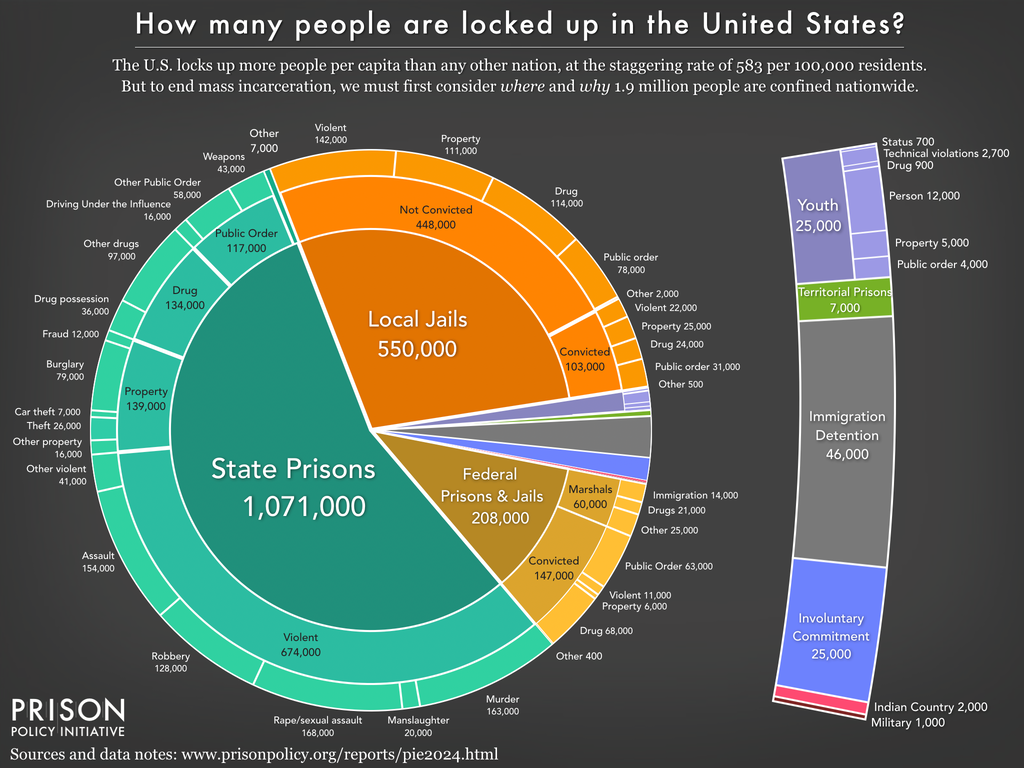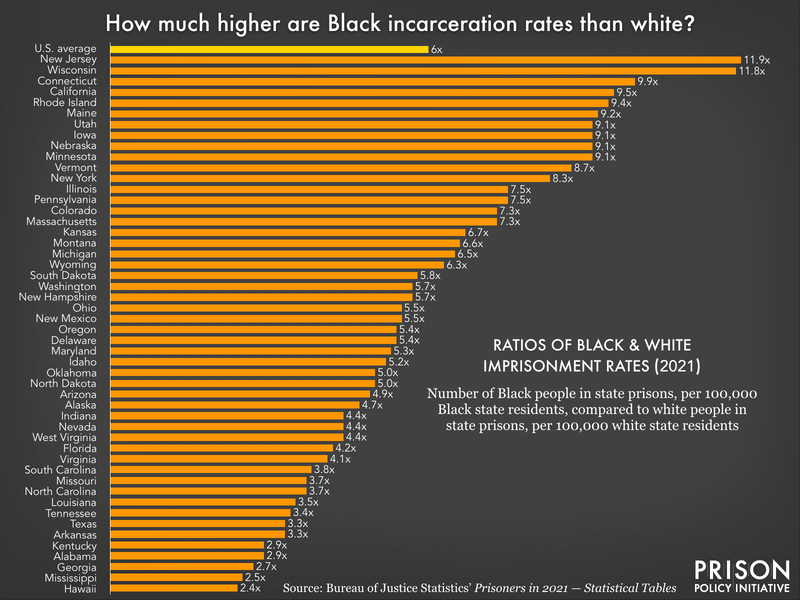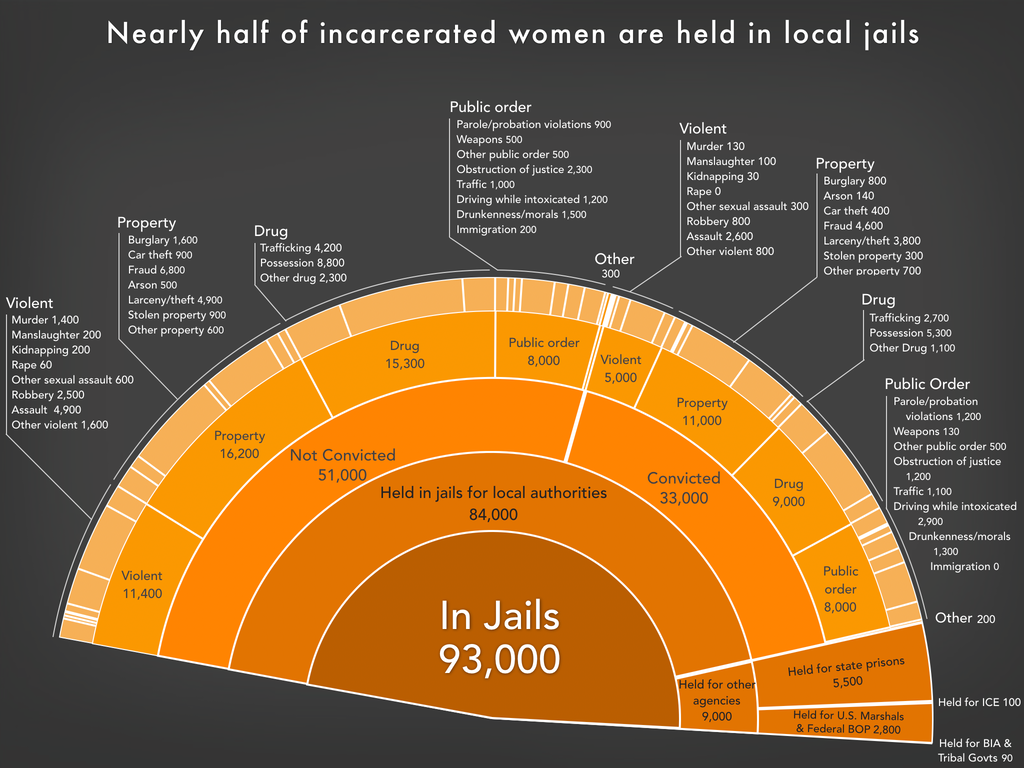Mass Incarceration 101: Resources to help students and teachers understand the carceral system
It’s back to school season, so we’ve curated information and tools for students and teachers to use when researching the carceral system.
by Danielle Squillante, September 3, 2024
Students and teachers are heading back to the classroom. In addition to math, science, and language arts, many will also focus on the criminal legal system and mass incarceration. Unfortunately for them, the carceral system operates like a black box, making it hard to study what’s happening inside the walls of prisons and jails. Fortunately, we have made it our business to make the data that does exist as accessible and understandable as possible.
To better support the work of students and teachers, we’ve curated a list of publications and tools they can use to better study the carceral system and that can serve as launchpads for further research.
Where to start: The big picture
To start any lesson on mass incarceration, you have to understand the U.S. doesn’t have one criminal legal system; instead, it has thousands of federal, state, local, and tribal systems that incarcerate a combined population of nearly 2 million people.
Our flagship report, Mass Incarceration: The Whole Pie, puts these pieces together to give the “big picture” of mass incarceration by explaining not only the scale of our carceral system but also the policy choices that have driven its expansion. It provides the most comprehensive picture of how many people are locked up in the U.S., in what types of facilities, and why. In addition to showing how many people are behind bars on any given day in the U.S., it goes on to bust 10 of the most persistent myths about prisons, jails, crime, and more.

Additional reading assignments:
- Our briefing on states’ reliance on excessive jailing explains the drivers of jail growth including the practice of renting jail space to state and federal agencies like the U.S. Marshals Service. The appendices include useful data on jail trends and population data over time.
- Our Punishment Beyond Prisons report looks at how many people in each state are on probation or parole. Notably, some of the states that are the least likely to send people to prison are among the most punitive when other methods of correctional control are taken into account.
- States of Incarceration: The Global Context shows how incarceration rates in the U.S. compare to countries across the globe. Although El Salvador has the highest incarceration rate of any country, the U.S. still has the highest incarceration rate of any independent democracy on earth — worse, every single state incarcerates more people per capita than most nations.
An essential lesson: Disparities in the system
No lesson about mass incarceration in America is complete without covering the stark racial disparities inherent in the system. Black people, for example, not only have higher incarceration rates than white people but are also more likely to receive harsher sentences, including life without parole and the death penalty.
To help teachers and students understand these disparities better, we produced a dataset containing over 100 state-specific graphics showing the number of people in state prisons and jails by race, ethnicity, and sex. Our data compares Black and white imprisonment rates by state, finding that every state locks up Black people at a rate at least double that of white people — and, on average, at six times the rate of white residents.

Additional reading assignments:
- Our Native incarceration page contains current data on the incarceration of Native people in jails, prisons, and Indian country jails. In jails, Native people have more than double the incarceration rate of white people, and in prisons, this disparity is even greater.
- Racial disparities aren’t the only disparities in the system. Our 2021 briefing on the system-involvement of LGBTQ people details how they are arrested, incarcerated, and subjected to community supervision at significantly higher rates than straight and cisgender people. This is especially true for trans people and queer women.
Gender studies: Women’s incarceration
Students and teachers looking to examine the carceral system must understand the unique ways that women experience mass incarceration in America.
Our Women’s Mass Incarceration: The Whole Pie report provides the most recent and comprehensive data on how many women are incarcerated in the U.S., in what kinds of facilities, and why. The report also includes rare self-reported data from a national survey of people in prison to offer new insights about incarcerated women’s backgrounds, families, health, and experiences behind bars. It examines why women’s incarceration has grown so rapidly in recent decades and explains that, because they are often primary caregivers to children, they’re not the only ones harmed by incarceration.

Additional reading assignments:
- Our briefing on how the fall of Roe v. Wade impacts women on probation and parole includes state-level data on how many women are under community supervision in states with abortion restrictions.
- Our 2020 briefing highlights the role that drug enforcement has played in the rise of women’s incarceration and makes clear why we need to pay attention to the ways that women are uniquely impacted by the legal system.
Care not cages: Incarceration and public health
People in prisons and jails are disproportionately likely to have chronic health conditions as well as substance use and mental health problems. Medical care in correctional facilities is notoriously inadequate, and because most prison systems charge copays for medical care, it also deters incarcerated people from seeking the care they need.
Our Chronic Punishment report shows that instead of “rehabilitating” people in prison (physically, mentally or otherwise), or at the very least, serving as a de facto health system for people failed by other parts of the U.S. social safety net, state prisons are full of ill and neglected people.

Additional reading assignments:
- Jails and prisons are often described as de facto mental health and substance abuse treatment providers, and corrections officials increasingly frame their missions around offering healthcare. But as our briefing on the lack of drug treatment in jails and prisons makes clear, most systems fail to provide evidence-based treatment options and instead rely on punitive responses to substance use.
- In our briefing on the aging prison population, we examine the inhumane, costly, and counterproductive practice of locking up older adults that is the consequence of a series of disastrous policy decisions in policing, sentencing, and reentry over roughly the last half-century.
- Our briefing on environmental injustice in prisons highlights how toxic detention facilities put the health of incarcerated people at risk. From having contaminated water to being sited near federal Superfund sites, prisons expose incarcerated people to hazardous substances that create additional health issues behind the wall.
Extra credit
Our website is chock full of data that can be used to further explore incarceration trends or dive deeper into issues related to mass incarceration:
- State Profile pages: contain current state-level data and visuals on a range of issues, including racial disparities and incarceration rates
- Data Toolbox: provides links to our unique datasets, including national and state-level population data
- Research Library: the nation’s largest online database of empirical and policy research about criminal legal issues, including mental health, community impacts of incarceration, and conditions of confinement
- Data Sources guide: includes descriptions of data sources we use to produce research exposing the harms of mass incarceration



